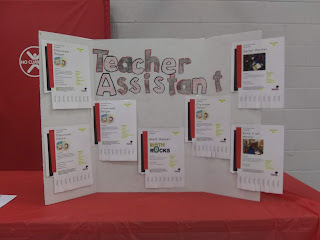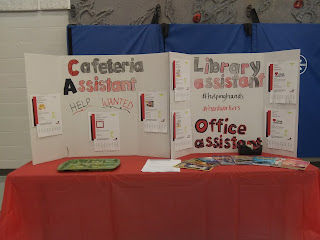Picture this: a sea of children’s faces that are beaming with excitement, so happy they are literally running around; kids helping each other out, even if they don't know each other; students rushing home to get help from their parents with something they cannot wait to turn in the next day, even if it isn’t due for another week. Any ideas what it may be that has elementary-aged students so enthusiastic? It is the opportunity to help out their very own school! That’s right! Students at Pioneer have been given the chance to take some ownership and pride in their school, and they can hardly wait to get started. Let me tell you about our new adventure!
My teaching partner, Arlene Wolf, and I are part of the district’s Teacher Leader Academy. Throughout this journey, we are responsible for finding ways to enrich our schools and district as a whole. We wanted to find a way to increase pride within our school community. Reflecting on the school year so far, I thought back to the beginning of the year when we had students in fourth and fifth grades apply for student council. We only have so many positions to fill and always way more applicants than spots. It’s always hard to turn away students who want to do great things for their school. After doing some brainstorming with Arlene and our building principal, Mr. Jeske, we came up with the idea of finding other ways that students could help. After checking into Meaningful Work: Changing Student Behavior with School Jobs through Safe and Civil Schools, our small-scale idea quickly snowballed into something much bigger. This book had inspiring ideas, and we were ready to get started on some “meaningful work.”
We used Meaningful Work for ideas but really focused on the needs of Pioneer. We asked teachers what help they needed within their classrooms and wrote down days and times of the week they requested. We also had them fill out a form letting us know what times throughout the week their students would be able to leave the classroom to “work”, if hired. We hit the halls and asked other staff members what jobs they envisioned students carrying out. When we had a list of student jobs, we created fliers to advertise the different positions.
The concept was to have the whole process be as authentic as possible, and Meaningful Work does just that. We put together student applications that reflected those from the book. We created interview questions to ask applicants. Yes, the students will not only fill out and turn in an application, but they will sit down with adults and take part in a mock interview. Then, at such an early age, they will either be accepted for the job…or not. That may seem a bit callous for this age group. I mean, imagine telling a kindergartner who’s jumping for joy at the thought of helping hand out birthday pencils, “Thank you for applying, but someone else is better for the job.”
Hold up! Just kidding! Obviously that is not how it will be handled, but it is a situation we’ll come across. We simply don’t have enough jobs available for all the students who apply. But think of what good teaching moments those will be when we can have conversations about perseverance, sportsmanship, and positive self-talk.
 Once things started coming together, we filled Mr. Jeske in on our progress and discussed how to kick-off Meaningful Work and get everyone in the school excited about it. We wanted it to be BIG! Mr. Jeske suggested a job fair, so we picked a date (January 16th), took the idea, and ran with it. We purchased trifold posters where we hung the fliers, spotlighted the positions available, and thought of catchy phrases to include to draw students in. We enlisted the help of our fifth graders who traced the letters on the trifold posters to spell out the job names, colored them in with our school colors, and created large banners to hang in the gym the day of the fair and smaller posters to put around the school. We asked teachers to sign up for a twelve-minute time slot from 2:00-3:00 the day of the fair so we could get everyone in and give all students a chance to browse the different jobs. On Tuesday and Wednesday (the day of the event), Mr. Jeske made morning announcements about the job fair. So began the excited chatter around the school.
Once things started coming together, we filled Mr. Jeske in on our progress and discussed how to kick-off Meaningful Work and get everyone in the school excited about it. We wanted it to be BIG! Mr. Jeske suggested a job fair, so we picked a date (January 16th), took the idea, and ran with it. We purchased trifold posters where we hung the fliers, spotlighted the positions available, and thought of catchy phrases to include to draw students in. We enlisted the help of our fifth graders who traced the letters on the trifold posters to spell out the job names, colored them in with our school colors, and created large banners to hang in the gym the day of the fair and smaller posters to put around the school. We asked teachers to sign up for a twelve-minute time slot from 2:00-3:00 the day of the fair so we could get everyone in and give all students a chance to browse the different jobs. On Tuesday and Wednesday (the day of the event), Mr. Jeske made morning announcements about the job fair. So began the excited chatter around the school.
The day of the job fair our awesome fifth graders helped us get everything set up. We had tables around the gym to display the posters and had available staff members stand at each table to promote jobs and answer questions. Once the first class entered, the energy in the room skyrocketed! Students’ eyes were wide with curiosity and excitement. They ran from table to table, trying to find the jobs they wanted. I had so many kids run up to me, eager to share the jobs they took applications for. For me, it was a feeling of pure elation! The satisfaction of many hours of work that had come together with a successful outcome; the notion of students wanting to help adults out around the school, some even before school hours; the vivacity of adults and students alike. Bliss!
Students took home applications that night and started bringing them back the next day. I had one Kindergarten teacher ask if a fifth grader could help one of her students fill out his application. He didn’t get it done the night before and was beside himself. She wanted to help him, but he insisted on having a fifth grader walk him through it. What a great experience for both! This is part of our hope with Meaningful Work: building a stronger sense of community. Students working with others from different grade levels and students working with staff members will bring our small Pioneer family even closer together. Students will develop/enhance lifelong skills: responsibility, respect, communication, collaboration, and pride in their school.
Our job is far from over. The next step is to figure out a schedule for interviewing that meets everyone’s needs and then to actually hold the interviews. From there, we need to “train” students who are hired so they experience success within their positions. There will be a lot of communication between Arlene, myself, and Pioneer staff to check in on how things are going and what needs to be changed. It’s a lot of work and a little overwhelming at times, but bird by bird we will get it done, and it will be amazing!
Q1: What student jobs would be helpful within your school?
Q2: How would you keep the excitement
levels up among students as time goes on and the idea is no longer “new”?
Q3: What issues do you see arising from
student jobs?
Q4: How do you encourage students to take
pride in their school?

